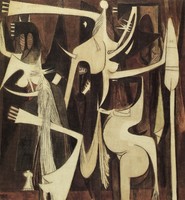Wifredo Lam
Wifredo Lam (Cuban artist, 1902-1982)
Lam came from a family which his father is Chinese and his mother is African European. He was raised in Cuba and studied art in Paris where he became close friend with Pablo Picasso. This friendship lasted for a very long time and it was Picasso who inspired him in cubism and the stay in Paris initiated him to think about his origin. This was the time when Lam had a great shift in his work. His early works were mostly academic art. After this inspiration, Lam started to worked on using cubism to draw about some specific culture that he could related. “Self Portrait, 1938” was the worked he done which he tried to connect with African art to define who he was. The face was the image of the African mask and with geometric shape to show the skills of cubism. This was the beginning of his search in his identity.
After twenty years in Paris, Lam returned to Cuba. He started to gain interest in Santeria which is a system of beliefs developed from west Africa. It is a religion which combined the Yoruba religion, Christianity, and the religions of the indigenous people of Africa. Lam’s work “Visitor, 1948” was using figures from Santeria but transformed into his own style of drawing. This point of time, Lam was a famous modern artist. He was using his fame to exhibit the part of African culture he wished the public to see. The relevant part of Lam’s art pieces was that identity could be chosen. There were other modern artists who were also using subjects of African culture to put in there drawing; yet they did not use it as a representation of themselves. Unlike the rest, Lam embraced this culture and converted into his own kind of individuality. He selected African culture because of the roots from his mother. Even though there was only a little African race in his blood, he showed that identity could be chosen.
Santeria was originated from west African and is practiced by Yoruba people, whom many of them were slaves in Cuba. This religion is based on Yoruba beliefs with some parts of Roman Catholic features. The link below is a website about detail information of Santeria:
"About Santeria"
http://www.aboutsanteria.com/what-is-santeria.html



